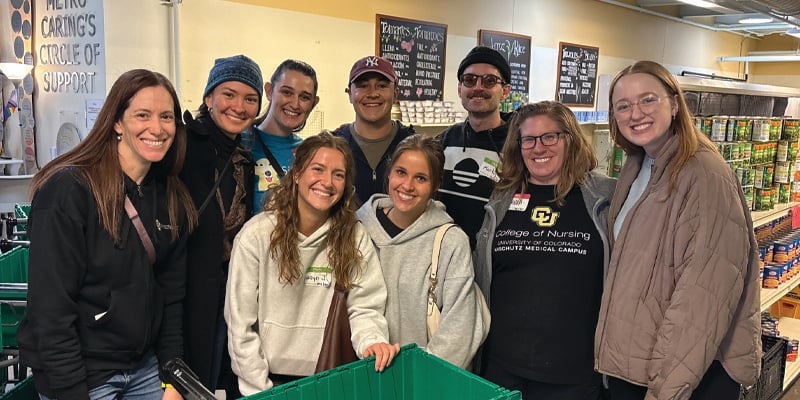Regional Director for Region 8 of the U.S. Department of Health and Human Services (HHS) Lily Griego visited Sheridan Health Services on Thursday, Aug. 25. Griego shared ideas with the clinic’s staff and other stakeholders on issues ranging from vaccine hesitancy in rural underserved communities to building a more diverse and inclusive healthcare workforce.
A Colorado native, Griego was appointed by President Joe Biden to lead HHS’s efforts in Region 8 – consisting of Colorado, Montana, North Dakota, South Dakota, Wyoming, and Utah, including American Indian reservations and sparsely populated areas where healthcare services and resources are scarce.
Griego, who earned a bachelor’s degree in political science and a master’s degree in history from the University of Colorado Denver, has extensive experience on critical policy issues such as immigration, education, and health equity.
One of four nurse-led practices operated by the University of Colorado College of Nursing, Sheridan Health Services is a federally qualified health center (FQHC) that Griego called “one of the best in the country.” With two locations serving adults and services, the clinic offers primary care and a comprehensive range of physical, behavioral, oral health, and pharmacy services.
COVID-19 concerns
Much of Thursday’s conversation focused on low COVID-19 vaccination rates among children six months to five years old. Statistics show only 6% of children nationwide (11% in Colorado) in the age range have received the vaccination since they made available in June of this year.
“There are a lot of concerns from parents – mostly around the fear of the unknown,” CU Nursing Instructor of Clinical Practice Mia Roberts, MSN, CPNP-PC, of Sheridan Health Services. “For most children, the symptoms have been relatively mild, so families are faced with whether to skip the vaccine or risk that their children will be among those experiencing the more severe side effects.”
On a cautionary note, Roberts pointed out that during the omicron surge earlier this year, children under the age of five were hospitalized at a rate five times higher than the Delta variant.
“This virus is very real for children of all ages, but in particular of this young age group,” she said. “Vaccinating our children and continuing to boost our families is the one way that we can really try to prevent the most serious effects of this virus such as hospitalization and death.”
Roberts encouraged parents to take advantage of vaccination sites throughout the area and to work with pediatric providers to ensure their children are vaccinated.
Equity barriers to health
Regarding the low vaccination rates for children, CU Nursing Clinical Director of Primary Care & Pediatrics Megan Champion, FNP, acknowledged there are specific concerns in underserved communities.
“When we’re talking about some of the racial and ethnic disparities we’re seeing in terms of the vaccination uptick in our Colorado population, we’re looking at some of the same things we were looking at with vaccinating our adult population – such as transportation, access to clinics that carry the vaccine and making sure that clinics are open for folks who have jobs that carry them into the evening,” Champion said. “A lot of those barriers are still there.”
Champion challenged healthcare professionals to think outside of the digital space in getting the word out about vaccines and to meet parents “where they live” to ensure their kids get vaccinated.
CU Nursing Associate Dean of Clinical and Community Affairs Rosario Medina, PhD, FNP-BC, ACNP, CNS, pointed out that the Sheridan clinic’s Hispanic-Latino community was initially hesitant to embrace telehealth during the pandemic “for a variety of cultural, linguistic and logistical reasons” – including fear of deportation.
In response, the clinic created a “call center” for patients with Spanish-speaking, culturally sensitive service representatives to guide patients through telehealth tools and to demystify telehealth.
“Sheridan implemented an example that should be replicated in other places because they would answer a telephone and that became a connecting point,” Medina said. “Many other places that used telehealth were not as successful. As a clinician myself, I see it as a positive component for people who have [internet] access. But we still have disparities. Just because we have technology doesn’t mean we can lock a lot of people out.”
For her part, Griego said that the HHS is putting funding into local communities to ensure that vaccinations and healthcare services are disseminated throughout the country and that she would take the feedback to her colleagues in Washington.
Building the healthcare workforce
The second half of the panel was dedicated to building a more diverse healthcare workforce for underserved communities.
Sheridan Health Services CEO Erica Sherer said one answer to the healthcare workforce problem is developing pipelines through community colleges to improve a pathway to competencies.
CU Nursing partners with local community colleges through the Integrated Nursing Pathway, a program that offers simultaneous application and admission to local community colleges to give students a head start on a bachelor of science degree in nursing.
In addition, CU Nursing is engaging in an innovative partnership with Durango-based Fort Lewis College to create a four-year undergraduate degree in nursing that will bring CU Nursing’s expertise to the rural and Indigenous serving campus in Southwest Colorado.
In closing, Griego said the meeting was helpful in stimulating ideas that could be implemented on a national level and raising issues for HHS and other agencies to consider in the future.
“This conversation is healthy in that we have lots to share and lots of opinions,” Griego said. “The point is that we’re having the conversations.”



